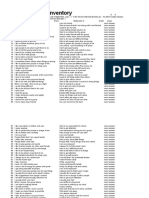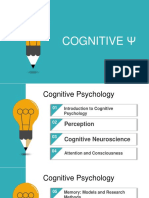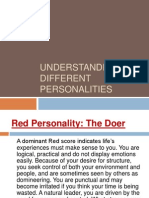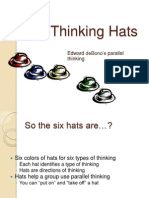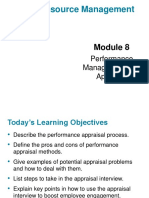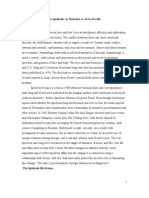Mbti Step Ii: Jane Sample
Mbti Step Ii: Jane Sample
Uploaded by
Nadya PryanaCopyright:
Available Formats
Mbti Step Ii: Jane Sample
Mbti Step Ii: Jane Sample
Uploaded by
Nadya PryanaOriginal Title
Copyright
Available Formats
Share this document
Did you find this document useful?
Is this content inappropriate?
Copyright:
Available Formats
Mbti Step Ii: Jane Sample
Mbti Step Ii: Jane Sample
Uploaded by
Nadya PryanaCopyright:
Available Formats
MBTI STEP II
EXPANDED INTERPRETIVE REPORT
by Naomi L. Quenk, Ph.D. and Jean M. Kummerow, Ph.D.
Prepared for
JANE SAMPLE
February 21, 2003
Copyright 1996 by CPP, Inc. 3803 E. Bayshore Road Palo Alto, CA 94303 All rights reserved.
PAGE 2
JANE SAMPLE 2/21/03
EXPANDED INTERPRETIVE REPORT
ABOUT THE MBTI
This report is an in-depth, personalized account of your personality preferences, derived from your answers on the Myers-Briggs Type Indicator Step II (MBTI Step II). The MBTI reports your individual personality type, and the Step II analysis of your responses gives you an indication of the unique way in which you express each main preference. The Myers-Briggs Type Indicator is designed to help you become acquainted with the personality gifts you were born with that make you a unique person. It was developed by Isabel Myers and Katharine Briggs as an application of Carl Jungs theory of psychological types. Jung believed that much of what we do with our minds is either an act of gathering or becoming aware of new information, which he called Perceiving, or an act of deciding or coming to a conclusion using that information, which he called Judging. He also believed that much of the apparent random difference in peoples behavior is actually a result of each person having preferences for particular ways of perceiving and judging. Jung identified Sensing and Intuition as two opposite ways of perceiving, and Thinking and Feeling as two opposite ways of forming judgments. These four different modes of perceiving and judging he called functions. People with a preference for Sensing take in new information by focusing on facts and details that can be confirmed by experience, whereas people who prefer Intuition focus on possibilities and relationships among ideas. People who prefer Thinking judgment use impersonal, objective, logical analysis to reach conclusions, whereas people who prefer Feeling judgment use person-centered, subjective analysis to reach their conclusions. These personality preferences are similar to the familiar preference each of us has for right-handedness or left-handedness. A person normally writes with one hand or the other, but not both. We face the same situation in using our mental functions: we can, and do, use each of the perceiving functions and each of the judging functions on occasion, but we normally reach for our preferred one first. Another pair of opposites, called Extraversion and Introversion, have to do with the sources of our energy and the way we use our functions. Jung called these opposites attitudes rather than functions. People with a preference for Extraversion focus on, and draw energy from, the people, events, and things in the outer world. People with a preference for Introversion, on the other hand, focus on and derive energy from the thoughts, feelings, and impressions of their inner world.
Copyright 1996 by CPP, Inc. 3803 E. Bayshore Road Palo Alto, CA 94303 All rights reserved.
PAGE 3
JANE SAMPLE 2/21/03
EXPANDED INTERPRETIVE REPORT
A second pair of opposite attitudes identifies whether a persons primary means of dealing with the outside world is one of the Perceiving functions or one of the Judging functions. People who prefer the Judging attitude like to plan and organize, make decisions quickly, and come to closure. People who prefer the Perceiving attitude tend to be spontaneous and adaptable and want to keep their options open as long as possible. The MBTI is not a measure of your abilities in any area. It is designed to help you become aware of your particular gifts and, through this process, to understand and appreciate the ways in which people differ. Remember that no preference is more desirable than its opposite, and no one of the sixteen possible basic types is better than any other. Contributed by Peter B. Myers
Your report contains: A. B. C. D. E. F. The four dimensions: your preferences Step II: The components of your preferences Understanding your type and its components as a whole The natural development of your type References Your MBTI Step II Profile 4 6 11 14 21 22
Copyright 1996 by CPP, Inc. 3803 E. Bayshore Road Palo Alto, CA 94303 All rights reserved.
PAGE 4
JANE SAMPLE 2/21/03
EXPANDED INTERPRETIVE REPORT
THE FOUR DIMENSIONS: YOUR PREFERENCES
The Four Preferences That Make Up Your Type
The MBTI describes four preference dimensions, each made up of a pair of opposites. All eight preferences are valuable, and everyone uses each of them at least some of the time. However, each individual tends to prefer one of each pair and generally uses it more than its opposite. Below, your reported preferences are indicated with a box.
WAYS OF GAINING ENERGY
EXTRAVERSION
INTROVERSION
You focus on your outside world and get energy through interacting with people and doing things.
You focus on your inner world and get energy through reflecting on information, ideas, and concepts.
WAYS OF TAKING IN INFORMATION
SENSING
INTUITION
You notice and trust facts, details, and present realities.
You attend to and trust interrelationships, theories, and future possibilities.
WAYS OF MAKING DECISIONS
THINKING
FEELING
You make decisions using logical, objective analysis.
You make decisions to create harmony by applying personcentered values.
WAYS OF LIVING IN THE WORLD
JUDGING
PERCEIVING
You prefer to be organized and orderly and to make decisions quickly.
You prefer to be flexible and adaptable and to keep your options open as long as possible.
REMEMBER: Even though you are probably more comfortable with one of each pair of opposites, you can and do use the other one some of the time.
Copyright 1996 by CPP, Inc. 3803 E. Bayshore Road Palo Alto, CA 94303 All rights reserved.
PAGE 5
JANE SAMPLE 2/21/03
EXPANDED INTERPRETIVE REPORT
YOUR PERSONALITY TYPE
Your four preferences, as described on the previous page, combine to form the personality type described below. Read the description carefully, noting which statements fit you well and which may not be accurate.
INTROVERTED, SENSING, THINKING, JUDGING
ISTJ
ISTJs are typically dependable, realistic, and practical. They are likely to absorb, remember, and use facts carefully and accurately. They like things clearly and logically stated. They are thorough, painstaking, systematic, hard-working, and careful with particulars and procedures. When they see something that needs to be done, they take on the responsibility for it, often beyond the call of duty. ISTJs do not enter into activities and projects impulsively, but once committed, they are very hard to distract or discourage. They stabilize things they are connected to and persevere even in the face of adversity. When they are on duty, ISTJs behavior is sound and sensible and they appear calm and composed. Even in a crisis they seldom show their highly individual, vivid, and intense inner reactions. People who dont know them well will often remain unaware of their total reaction. ISTJs practical judgment and respect for procedures makes them come across as consistent and moderate. They assemble the necessary facts to support their evaluations and decisions and they communicate them in an objective way. They look for solutions to current problems in their own past experience and that of others. ISTJs are likely to be most satisfied when they can work in an environment that values organization and accuracy. People can count on them for noticing what needs to be done and following through in a careful, methodical, and timely manner.
Copyright 1996 by CPP, Inc. 3803 E. Bayshore Road Palo Alto, CA 94303 All rights reserved.
PAGE 6
JANE SAMPLE 2/21/03
EXPANDED INTERPRETIVE REPORT
STEP II: THE COMPONENTS OF YOUR PREFERENCES
Each preference dimension is broad and complex, and includes many interconnected parts. Knowing your preferences for the parts, or components, of the ExtraversionIntroversion (EI), SensingIntuition (SN), ThinkingFeeling (TF), and JudgingPerceiving (JP) dimensions can help you better understand your basic personality type. The next four pages examine the components of your type. As you review how aspects of your personality are described by each of the components, keep in mind the following: Five components are included for each preference dimension, but each may have other parts that have not yet been identified. Further, each dimension is greater than the sum of its partsjust as your basic type is greater than the sum of the four preference dimensions. Each of the components has two opposite poles. A person is most likely to favor the pole associated with his or her overall preference. For example, an Extravert will typically prefer most of the Extraverted poles of the EI dimension; an Introvert will likely favor most of the Introverted poles. For any particular component, however, a person may favor the opposite pole or show a mixed preference. A preference for an opposite pole is an out-of-pattern preference. A mixed preference may indicate no clear preference for either pole, or the use of one or the other poles depending on the situation. Your pattern of component preferences for a preference dimension shows your unique way of expressing that overall preference. Each Extravert, for example, is extraverted in a different way, depending on his or her preferences for the component parts of the EI dimension. The pole you prefer for each component is shown with a box. If you have elements of preference for aspects of both poles, the Mixed position is boxed. A set of statements below your boxed preference describes characteristics of that preference. Some descriptive terms for the opposite pole (or for both poles in the case of Mixed) are included for comparison.
On each of the next four pages:
Evaluate how well the statements for each component describe you. If a set of statements doesnt seem to fit, consider the possibility that you are better described as favoring the opposite pole or a mixture of the poles (or one of the poles if you are described as Mixed.) The definitions of the poles of each component (presented with your Profile on the last two pages of this report) may help you evaluate the accuracy of your indicated preferences.
Copyright 1996 by CPP, Inc. 3803 E. Bayshore Road Palo Alto, CA 94303 All rights reserved.
PAGE 7
JANE SAMPLE 2/21/03
EXPANDED INTERPRETIVE REPORT
COMPONENTS OF EXTRAVERSION (E) AND INTROVERSION (I)
Remember that you indicated an overall preference for using Introversion (I) as a way of gaining energy. Your preference for each of the component parts of ExtraversionIntroversion is shown below.
EXTRAVERSION
INITIATING
INTROVERSION
MIXED
Will initiate conversations in social situations with people you already know. Appear socially at ease in familiar situations. Are willing to introduce people to each other if no one else does so, but would prefer not to.
RECEIVING
EXPRESSIVE
Demonstrative Easier to know Self-revealing
MIXED
CONTAINED
Keep your feelings and interests to yourself. Are seen by others as hard to get to know. Assume others will be uninterested in your thoughts. Deal with your emotions internally, by yourself. Feel capable of solving problems on your own and enjoy doing so. Find it very hard to discuss what upsets you, especially when you are extremely upset.
GREGARIOUS
Seek popularity Broad circle Join groups
MIXED
INTIMATE
Would rather relate to a few significant others than be in a large group. Draw sharp distinctions between friends and acquaintances. Need to trust people before sharing much about yourself. Seek close, one-to-one, in-depth involvement with others. Recognize people as individuals and expect similar treatment.
PARTICIPATIVE
Interactor Enjoy contact Listen and speak
MIXED
REFLECTIVE
Prefer detached observation and reflection over active participation with the outer world. Learn best from reading and writing and communicate best through writing. Can concentrate better on written material than on someone talking. Feel more secure writing down your ideas than giving an oral presentation.
ENTHUSIASTIC
Lively Energetic Seek spotlight
MIXED
QUIET
Prefer calm, serenity, even silence. Are bothered by noisy circumstances and places. Dont feel the need to talk in a social situation. Present yourself modestly and conservatively and prefer to stay in the background. Like being with other quiet people.
Copyright 1996 by CPP, Inc. 3803 E. Bayshore Road Palo Alto, CA 94303 All rights reserved.
PAGE 8
JANE SAMPLE 2/21/03
EXPANDED INTERPRETIVE REPORT
COMPONENTS OF SENSING (S) AND INTUITION (N)
Remember that you indicated an overall preference for taking in information through Sensing (S). Your preference for each of the component parts of Sensing Intuition is shown below.
SENSING
CONCRETE
Are grounded in reality and trust the facts. Interpret things literally. Are cautious about making inferences. May find it hard to see trends and link facts to the bigger picture. Begin with what you know to be true, and have all the facts in order before moving on. May be seen by others as resistant to change, although you may not see yourself that way.
INTUITION
MIXED ABSTRACT
Figurative Symbolic Intangible
REALISTIC
MIXED
Like to search for and find new ideas or methods. Carefully avoid embracing anything that seems too farfetched or that involves a lengthy search. Move relatively quickly to see how your ideas work and what their limits are. Stay in touch with the common sense aspects of any situation.
IMAGINATIVE
PRACTICAL
Pragmatic Results-oriented Applied
MIXED
INFERENTIAL
Read avidly and enjoy exploring the world of ideas. Research a problem by finding out what has been written about it. May be more attracted to an academic career in your area than in being a practitioner. Build a conceptual framework from the facts. Need facts and examples to make abstract concepts real. Are good at refining and improving on others ideas.
EXPERIENTIAL
Learn best from direct experience and rely on it to guide you. Are careful not to over generalize. Focus more on the past and present than the future. Enjoy what is happening now rather than think about meanings and theories. May sometimes get stuck on details at the expense of larger considerations.
MIXED
THEORETICAL
Conceptual Hypothetical Trust theories
TRADITIONAL
Identify strongly with what is familiar. Are comfortable with the tried and true because it provides a precedent to follow. Admire and support established institutions and methods. Are reluctant to change things that are working well. Enjoy participating in rituals and traditions at work and at home.
MIXED
ORIGINAL
Unconventional Different New and unusual
Copyright 1996 by CPP, Inc. 3803 E. Bayshore Road Palo Alto, CA 94303 All rights reserved.
PAGE 9
JANE SAMPLE 2/21/03
EXPANDED INTERPRETIVE REPORT
COMPONENTS OF THINKING (T) AND FEELING (F)
Remember that you indicated an overall preference for making decisions using Thinking (T). Your preference for each of the component parts of Thinking Feeling is shown below.
THINKING
LOGICAL
Believe that logical analysis is the best basis for good decision making. Use sequential reasoning, with premises and defined rules, to arrive at consistent conclusions. Use hard data to support your decisions. Focus on cause and effect. Like to maintain clear boundaries between issues. Can easily identify the pros and cons of an issue.
FEELING
MIXED EMPATHETIC
Personal Feeling Central values
REASONABLE
Justice Truthful Cause-and-effect
MIXED
COMPASSIONATE
Consider yours and others feelings above the logic of a situation. Notice and are swayed by emotions even when logic points in another direction. Feel torn between the objective and subjective, and often go with the latter.
QUESTIONING
MIXED
Ask questions only as needed. Ask questions mildly and tactfully to satisfy your curiosity. Question and disagree in a style that is neither confrontational nor conciliatory. Become more confrontational and direct when an important value is threatened.
ACCOMMODATING
CRITICAL
Skeptical Want proof Critique
MIXED
ACCEPTING
Welcome the broadest range of ideas and approaches. Appear to accept all ideas equally, not imposing your thoughts on others. Prefer a participative management style. Are modest about your own work and may be reluctant to promote it over others ideas. Are seen as open, fair, and approachable; but some people may be confused about what you really believe and think.
TOUGH
Firm Tough-minded Ends-oriented
MIXED
TENDER
Are concerned with how people feel. Prefer using gentle persuasion and warm understanding to influence others. Believe it is only logical to include people. Think it is unfair to take advantage of people even when you are in a stronger position.
Copyright 1996 by CPP, Inc. 3803 E. Bayshore Road Palo Alto, CA 94303 All rights reserved.
PAGE 10
JANE SAMPLE 2/21/03
EXPANDED INTERPRETIVE REPORT
COMPONENTS OF JUDGING (J) AND PERCEIVING (P)
Remember that you indicated an overall preference for living your life using Judging (J). Your preference for each of the component parts of Judging Perceiving is shown below.
JUDGING
SYSTEMATIC
Thoroughly plan for whatever you face. Plan for the worst-case scenario with many contingencies in place. Work within a superstructure of efficiency. Dislike any kind of diversion. Do not like surprises.
PERCEIVING
MIXED CASUAL
Relaxed Easygoing Welcome diversions
PLANFUL
Like to look ahead and make long-range plans. Feel its your duty to be concerned about the future. May enjoy the planning more than the doing. Feel that long-range planning makes you more efficient and ensures that things will happen the way you want.
MIXED
OPEN-ENDED
Present-focused Go with the flow Like flexible plans
EARLY STARTING
Allow yourself plenty of time to accomplish an activity efficiently. Dont like feeling overwhelmed by having too much to do. Work on multiple tasks comfortably by starting ahead of time and working on each task for short, concentrated periods of time. Dont run from stress, but arrange your world so you dont have to deal with it much. Cant forget incomplete tasks; feel calm and satisfied when you complete something.
MIXED
PRESSURE-PROMPTED
Motivated by pressure Bursts and spurts Early start unmotivating
SCHEDULED
Are comfortable with routines and do not like them upset. Like established methods and procedures. Prefer to control how you spend your time. Enjoy scheduling both work and fun activities. Seem rather predictable to others but like it that way.
MIXED
SPONTANEOUS
Like variety Enjoy the unexpected Procedures hinder
METHODICAL
Develop detailed plans for the task at hand. Define the subtasks of your work, including the order in which things should happen. Thoroughly prepare in precise ways, specifying all the steps needed to accomplish the goal.
MIXED
EMERGENT
Plan loosely Plans emerge Adaptable
Copyright 1996 by CPP, Inc. 3803 E. Bayshore Road Palo Alto, CA 94303 All rights reserved.
PAGE 11
JANE SAMPLE 2/21/03
EXPANDED INTERPRETIVE REPORT
UNDERSTANDING YOUR TYPE AND ITS COMPONENTS AS A WHOLE
Your Expanded Type Description
As you recall, the type description you read on page 5 was for
ISTJ
INTROVERTED, SENSING, THINKING, JUDGING
The component descriptions you read on the previous four pages show your unique way of expressing your type. Do the descriptions fit for you? If yes, you might find it interesting and useful to expand your type description to include the component poles you favor that are out of pattern for a person of your type. Incorporating these poles, your type description expands to:
INFERENTIAL, COMPASSIONATE, ACCEPTING, TENDER,
ISTJ
The distinctive way that you experience and express your type helps explain how you are similar to and different from others of your type. Other ISTJs can be unique in quite different ways, although you still have much in common with them.
Copyright 1996 by CPP, Inc. 3803 E. Bayshore Road Palo Alto, CA 94303 All rights reserved.
PAGE 12
JANE SAMPLE 2/21/03
EXPANDED INTERPRETIVE REPORT
How Your Four Preferences Work Together
Now that you know your four main preferences and their components, and have some understanding of what each of your preferences means, we can look at how they work together to form your personality.
THE ORDER OF YOUR FUNCTIONS
The four functionsSensing, Intuition, Thinking, and Feelingrepresent the ways of taking in information and making decisions. Each type has a favorite function and a second favorite function, represented by the two middle letters of the four-letter type. The other two functions, whose letters dont appear in the four-letter type, are third and fourth in importance. For ISTJs, the pattern works like this: ISTJs like Sensing best Thinking next Feeling third
Intuition least
HOW YOU USE YOUR FAVORITE FUNCTIONS
Extraverts like to use their favorite function in the outer world of people and things. For balance, they use their second favorite function in their inner world of ideas and impressions. Introverts prefer to use their favorite function mostly in their inner world, and to balance this with the use of their second favorite function in the outer world. ISTJs use
Sensing mainly internally: to consider the facts and details they have stored in their heads. Thinking mainly externally: to communicate their structured, logical decisions to others.
Copyright 1996 by CPP, Inc. 3803 E. Bayshore Road Palo Alto, CA 94303 All rights reserved.
PAGE 13
JANE SAMPLE 2/21/03
EXPANDED INTERPRETIVE REPORT
WHEN YOU USE YOUR LESS-PREFERRED FUNCTIONS
When ISTJs do use Intuition and Feeling (usually because the situation requires it), they may feel uncomfortable or awkward. If they have to devote a lot of time and energy to using these functions, they can become tired, frustrated, and out of sorts. When this happens, many ISTJs find it helpful to: remember that they are working outside of their natural comfort zone. take a break from the less familiar ways of operating. do something enjoyable that involves using their Sensing and Thinking.
Using and Developing Your Type Effectively
ISTJs preference for Sensing and Thinking makes them mostly interested in acquiring and using facts and experiences and in reaching logical conclusions about them. They typically devote much less energy to the less-preferred parts of their personality, Intuition and Feeling. These parts may remain unexercised and be less available for use in situations where they might be helpful. As an ISTJ, if you rely too much on your Sensing, you are likely to miss the big picture and new possibilities. If you make judgments exclusively using Thinking, you may ignore the impact of your decisions on people and find them resisting your plans.
USING YOUR LESS-PREFERRED FUNCTIONS
To gain access to Intuition and Feeling, consider the components of Sensing Intuition and ThinkingFeeling on which you were out-of-pattern or a mix. These components may serve as bridges to the less familiar parts of your personality and may help you use those parts more effectively. You may also wish to consult with someone whose preferences are opposite to yours to bring in a different perspective. This is especially helpful when working on major projects or making important decisions.
MODIFYING YOUR APPROACH IN SPECIFIC WAYS
Sometimes a particular task or situation calls for an approach opposite to your natural one. For example, a Scheduled person may find that in certain situations a Spontaneous approach might be more appropriate. Or a person who prefers the Abstract pole may need to focus on the Concrete information that is available. When such a situation occurs, you may benefit from reading a description of the pole that is opposite to yours to get a sense of how you would act when taking that approach.
Copyright 1996 by CPPs, Inc. 3803 E. Bayshore Road Palo Alto, CA 94303 All rights reserved.
PAGE 14
JANE SAMPLE 2/21/03
EXPANDED INTERPRETIVE REPORT
The Natural Development of Your Type
Many people find that as they get older, they become more interested in using the less familiar parts of their personality. ISTJs who are in mid-life or older find themselves devoting more time to things that were not very appealing when they were younger. For example, they report greater pleasure in considering new ways of doing things and in devoting more time to personal relationships. All parts of your personality are valuable and they are available to you over your entire life span. Your type develops and interacts with life experience in ways that help you deal with the different stages and tasks of life. This natural development is another way in which the whole of your type is greater than the sum of its parts.
Verifying Your Type
If after reading your report you dont think that ISTJ describes you adequately, perhaps a different four-letter type will. As a starting point: 1. Focus on any preference you thought was incorrect. 2. Look at any preference for which you are out-of-pattern or mixed. 3. Read the type description for the type you would be if the letter or letters you question were the opposite preference. (See the references on page 21.) 4. Consult your MBTI interpreter for suggestions. 5. Observe yourself and ask others how they see you.
APPLICATIONS
Knowledge of type can enrich your life in several ways. It can help you: Better understand yourself. Knowing your own type helps you understand how you typically react to situations and how that may help or hinder you. Understand others. Knowing about type in general helps you recognize that other people may have different styles than you. It can help you see those differences as useful and broadening to you, rather than annoying. Gain perspective. Seeing yourself and others in the context of type can help you achieve some objectivity and avoid getting stuck in believing your way is the only way.
When you face specific kinds of tasks or situations that involve interacting with others, it can be particularly useful to focus on your and others component preferences, rather than on whole types. In this section, we describe how your component preferences are likely to affect your approach to communicating, problem solving, change management, and conflict management, and how others component preferences may come into play. Throughout, the intention is to help you apply your type knowledge to achieve the most desirable outcomes in each type of situation.
Copyright 1996 by CPP, Inc. 3803 E. Bayshore Road Palo Alto, CA 94303 All rights reserved.
PAGE 15
JANE SAMPLE 2/21/03
EXPANDED INTERPRETIVE REPORT
Communicating
All aspects of your type influence how you communicate, especially as part of a team. Seven of the components are particularly relevant to communication. Your preferences for these seven components indicate that when you communicate, you most likely: Are willing to introduce people to one another if no one else is doing so (combining initiating and receiving). Keep your emotional reactions to yourself rather than say whats really on your mind (contained). Like to communicate through written words rather than through talking and listening (reflective). Discuss the here-and-now detail instead of possibilities and connections (concrete). Feel comfortable asking some questions, as long as they do not distract the group from reaching consensus (combining questioning and accommodating). Start tasks early instead of near the deadline (early starting). Identify the steps and their order before starting a task, rather than wait to see what seems the right thing to do when you begin (methodical).
You might find it useful to review the characteristics of the opposite poles of these seven communication-relevant components. (Remember, youll find them with your profile at the end of this report.) This may help you identify and better understand people with whom you have difficulty communicating.
TIPS TO ENHANCE COMMUNICATION
Understanding other peoples ways of communicating can encourage a more cooperative and productive approach to accomplishing the task. You may find the following general suggestions helpful for improving communication and achieving desirable outcomes. Tell others your particular needswhen you need more information, and what kind of information would be most helpful. Negotiate with them so that you can get at least some of whats important to you. Solicit from others what they need. Check with them to see if they have the information they find useful. Monitor your own level of impatience and annoyance when different communication styles dominate the communication process for too long. Understand others needs to use those different styles. You may have to compromise. Realize that others are not trying to annoy you when they talk a great deal, ask too many questions, are too accommodating, or want endless details. They are only trying to get what they need for communicating.
PAGE 16
JANE SAMPLE 2/21/03
EXPANDED INTERPRETIVE REPORT
Problem Solving
Good problem solving is based on accurate perception of information (taking in information through Sensing and Intuition) and on sound judgment (making decisions through Thinking and Feeling). The best decisions come from using all four functions, not just the two you most prefer. The component parts of the SensingIntuition and ThinkingFeeling dimensions can help you consider approaches and perspectives that you might otherwise neglect in favor of your preferred modes of operating. Each pole of each component suggests a certain kind of question you can ask about the problem. If you consider all these questionsnot just the ones associated with your preferencesyou can be sure youre covering all the bases. General forms of the questions are listed below. As a helpful reminder, the questions associated with the poles you prefer are boldfaced (if you use a mixture of the poles, neither pole is boldfaced).
SENSING
Concrete: What are the current facts? Realistic: What are the practical costs? Practical: What might work best? Experiential: What has been tried? Traditional: What are we currently doing?
INTUITION
Abstract: What else could this mean? Imaginative: Whats another way? Inferential: What ideas are relevant? Theoretical: What is the underlying theme? Original: What is new?
THINKING
Logical: What are the pros and cons? Reasonable: Whats logical? Questioning: What else do we need to know? Critical: What is wrong with this? Tough: What is the right way to do it?
FEELING
Empathetic: What do we like? Compassionate: How are we impacting people? Accommodating: How can we cooperate and please everyone? Accepting: What is right with this? Tender: What do we agree upon?
PROBLEM-SOLVING TIPS
In individual problem solving, ask yourself the questions above, and pay attention to the answers. The questions opposite boldfaced ones may be particularly illuminating, since they represent perspectives you arent likely to consider. You may find yourself becoming more circumspect because you are considering different kinds of information and points of view, not just what comes to mind first. In group problem-solving, encourage people with varying perspectives to contribute their views and concerns. Do a final check to make sure all the questions above have been asked.
Copyright 1996 by CPP, Inc. 3803 E. Bayshore Road Palo Alto, CA 94303 All rights reserved.
PAGE 17
JANE SAMPLE 2/21/03
EXPANDED INTERPRETIVE REPORT
YOUR DECISION-MAKING STYLE
The way you make decisions has a major influence on the way you solve problems. Your preferences on two of the components of the ThinkingFeeling dimension (LogicalEmpathetic and ReasonableCompassionate) combine to form your decision-making style. As part of your style, you: Work very hard to gain consensus. Are generally seen as self-determined, efficient, and confident. May sometimes appear unpredictable in your decisions. Are seen as concerned, caring, and flexible when you make decisions. May regret decisions that you made when your compassion overruled your initial logical approach.
DECISION-MAKING TIPS
In individual decision-making, note your overall decision-making style and how you best make decisions. Then, consult the less-preferred parts of your personality for a broader perspective. For example, if you usually use Thinking components in your decision making, consider the Feeling components. In group decision-making, encourage people with different outlooks to contribute their views. If all perspectives are present, actively encourage their participation. If you are missing a perspective, make extra efforts to consider what it might add.
Copyright 1996 by CPP, Inc. 3803 E. Bayshore Road Palo Alto, CA 94303 All rights reserved.
PAGE 18
JANE SAMPLE 2/21/03
EXPANDED INTERPRETIVE REPORT
Change Management
Change seems to be an inevitable part of our lives, whether we embrace it or resist it. All aspects of your type impact your style of managing change. The components most directly involved in change management relate to how a change is decided upon, whats involved in the change, how the change is communicated, and how its implemented. Your preferences for these components indicate that in the process of managing change, you most likely: Want to know that the change was decided upon after both logical analysis and a consideration of peoples feelings (combined Thinking Feeling style of decision-making). Keep your feelings about the change to yourself and attempt to resolve them on your own, rather than freely share those feelings with others (contained). Discuss the changes and their impact on you with only those closest to you (intimate). Have a concern for both the cost-effectiveness and the novel possibilities of the proposed changes (combining realistic and imaginative). Hope that many of the established ways of doing things will continue, rather than seeking as many new ways as possible (traditional). Plan as far in advance as possible for the changes rather than let them just happen as they may (planful). Detail the many steps necessary to implement the changes rather than just let the moment decide whats best to do (methodical).
CHANGE MANAGEMENT TIPS
Understanding your own and others ways of dealing with change can lead to smoother and less disruptive transitions. You may find that applying the following general suggestions will help you and others minimize stress and maximize the desirable outcomes that can accompany change. Identify what you need to understand the changes, and attempt to find that information. Work to encourage people to bring their thoughts and feelings out into the open, but be aware that some people need more talk time than others. Describe what is the same and what has changed as clearly as possible. Make sure that both thinking reasons and feeling values have been considered.
Copyright 1996 by CPP, Inc. 3803 E. Bayshore Road Palo Alto, CA 94303 All rights reserved.
PAGE 19
JANE SAMPLE 2/21/03
EXPANDED INTERPRETIVE REPORT
Conflict Management
In working with others, conflicts often arise over what is the best way to do something. These conflicts affect the relationships people have with one another and impact how they feel about their work. Six components relate specifically to conflict management. Your preferences for these components suggest that in managing conflict, you likely: Attempt to solve the issue yourself and keep your reactions inside, rather than discuss your feelings readily with others (contained). Rely on yourself or a few trusted others in resolving the conflict, rather than including as many people as possible (intimate). Ask some questions for clarification before reaching agreement (combining questioning and accommodating). Look for points of agreement in others arguments and ideas rather than find the flaws (accepting). Strive for cooperation rather than push your way through (tender). Pay attention to both the logic of the situation and the people and their feelings (combined ThinkingFeeling style of decision-making).
TIPS FOR MANAGING CONFLICT
Understanding others ways of handling conflict can lead to quicker and more satisfying conflict resolutions. The following general suggestions have been found to minimize the negative outcomes of conflict and enhance the positive outcomes. Taking care of both completing the task and maintaining your relationships with the people involved is important in conflict management. Understanding your own and others styles of communicating and handling conflict makes it possible to achieve both of these goals. All perspectives have something to add, but any perspective used in its extreme and to the exclusion of its opposite will ultimately detract. Negotiate with others to agree on when and with whom discussion will occur so everyone can be prepared and involved in the manner they wish.
Copyright 1996 by CPP Press, Inc. 3803 E. Bayshore Road Palo Alto, CA 94303 All rights reserved.
PAGE 20
JANE SAMPLE 2/21/03
EXPANDED INTERPRETIVE REPORT
Conclusion
You may find that in interacting with others, the perspective of type provides both objectivity and understanding, enabling you to act with greater confidence. Instead of reacting to the pressures of the moment, you can stand back and be more proactive. Remember that no one perspective is always right or always wrong. Consider the situation and what is needed. Remember that others may need different things than you, and be willing to openly discuss those needs. See if compromise is possible. If you want to further explore the applications and theory of the type perspective, the list of references on the next page can point you to some good sources of information. You may also find that continuing to observe both yourself and others from the standpoint of type enriches your understanding of personality differences and the dynamics of social interaction.
Copyright 1996 by CPP, Inc. 3803 E. Bayshore Road Palo Alto, CA 94303 All rights reserved.
PAGE 21
JANE SAMPLE 2/21/03
EXPANDED INTERPRETIVE REPORT
REFERENCES
For further reading, you might wish to consult:
Barger, N.J. & Kirby, L.K. (1995). The Challenge of Change in Organizations. Palo Alto, CA: Davies-Black Publishing. Hirsh, S.K., & Kummerow, J.M. (1989). LIFETypes. New York: Warner Books. Hirsh, S.K., & Kummerow, J.M. (1990). Introduction to Type in Organizations (2nd ed.). Palo Alto, CA: Consulting Psychologists Press. Kummerow, J.M. & Quenk, N.L. (1992). Interpretive Guide for the MBTI Expanded Analysis Report. Palo Alto, CA: Consulting Psychologists Press. Kummerow, J.M. & Quenk, N.L. (1992). Workbook for the MBTI Expanded Analysis Report. Palo Alto, CA: Consulting Psychologists Press. Myers, I.B. (1980). Gifts Differing. Palo Alto, CA: Davies-Black Publishing Myers, I.B. (1993). Introduction to Type. Palo Alto, CA: Consulting Psychologists Press. Myers, K.D. & Kirby, L.K. (1994). Introduction to Type Dynamics and Development. Palo Alto, CA: Consulting Psychologists Press. Quenk, N.L. (1993). Beside Ourselves: Our Hidden Personality in Everyday Life. Palo Alto, CA: Davies-Black Publishing. Quenk, N.L. (1996). In the Grip: Introduction to Our Hidden Personality. Palo Alto, CA: Consulting Psychologists Press.
Copyright 1996 by CPP, Inc. 3803 E. Bayshore Road Palo Alto, CA 94303 All rights reserved.
PAGE 22
JANE SAMPLE 2/21/03
EXPANDED INTERPRETIVE REPORT
Your Individual Type: ISTJ
ISTJs tend to be serious, quiet, thorough, and dependable. They see to it that everything is well organized and accurate. They are practical, orderly, matter-offact, logical, realistic and take responsibility. They notice what needs to be done and follow through steadily, regardless of protests or distractions.
E S T J
60 40 20 0 20 40 60
I N F P
The length of the bars on the graph above show how consistently you chose one pole of a preference rather than the other. A longer bar suggests that you are quite sure that you prefer that pole; a shorter bar suggests that you are less sure about your preference for that pole.
Your Subscale Results
Scores closer to the 0 pole indicate an Extraverted, Sensing, Thinking, or Judging component; scores closer to the 10 indicate an Introverted, Intuitive, Feeling, or Perceiving component.
EXTRAVERSION (E) 0 INITIATING Congenial Active Introduce people EXPRESSIVE Demonstrative Easier to know Self-revealing GREGARIOUS Seek popularity Broad circle Join groups PARTICIPATIVE Interactor Enjoy contact Listen and speak ENTHUSIASTIC Lively Energetic Seek spotlight
10 INTROVERSION (I)
RECEIVING Reserved Low-key Are introduced
10
CONTAINED Controlled Harder to know Private INTIMATE Seek intimacy One-on-one Find individuals REFLECTIVE Onlooker Prefer space Read and write QUIET Calm Enjoy solitude Seek background
Copyright 1996 by CPP, Inc. 3803 E. Bayshore Road Palo Alto, CA 94303 All rights reserved.
PAGE 23
JANE SAMPLE 2/21/03
EXPANDED INTERPRETIVE REPORT
SENSING (S) 0 CONCRETE Exact facts Literal Tangible REALISTIC Sensible Matter-of-fact Seek efficiency PRACTICAL Pragmatic Results-oriented Applied EXPERIENTIAL Hands-on Empirical Trust experience TRADITIONAL Conventional Customary Tried-and-true
10 INTUITION (N)
ABSTRACT Figurative Symbolic Intangible
IMAGINATIVE Resourceful Inventive Seek novelty
INFERENTIAL Scholarly Idea-oriented Intellectual THEORETICAL Conceptual Hypothetical Trust theories ORIGINAL Unconventional Different New and unusual
THINKING (T) 0 LOGICAL Impersonal Thinking Objective analysis REASONABLE Justice Truthful Cause-and-effect QUESTIONING Precise Challenging Enjoy a debate CRITICAL Skeptical Want proof Critique TOUGH Firm Tough-minded Ends-oriented
10 FEELING (F)
EMPATHETIC Personal Feeling Central values
COMPASSIONATE Sympathy Tactful Loyalty ACCOMMODATING Approving Uncritical Enjoy harmony
10
ACCEPTING Tolerant Trusting Praise TENDER Gentle Tender-hearted Means-oriented
JUDGING (J) 0 SYSTEMATIC Orderly Structured Dislike diversions PLANFUL Future-focused Advance planner Like firm plans EARLY STARTING Motivated by self-discipline Steady progress Late start stressful SCHEDULED Like routine Enjoy structure Procedures help METHODICAL Plan specific tasks List subtasks Organized
10 PERCEIVING (P)
CASUAL Relaxed Easygoing Welcome diversions OPEN-ENDED Present-focused Go with the flow Like flexible plans
PRESSURE-PROMPTED Motivated by pressure Bursts and spurts Early start unmotivating SPONTANEOUS Like variety Enjoy the unexpected Procedures hinder
EMERGENT Plan loosely Plans emerge Adaptable
Copyright 1996 by CPP, Inc. 3803 E. Bayshore Road Palo Alto, CA 94303 All rights reserved.
MBTI
JANE SAMPLE 2/21/03
STEP II PROFILE
EXTRAVERSION SENSING THINKING JUDGING
E S T J
60 50 40 Very Clear 30 Clear 20 10 Moderate 0 Slight 10 20 Moderate 30 Clear 40 50 60 Very Clear
I N F P
INTROVERSION INTUITION FEELING PERCEIVING
ISTJs -- Serious, quiet, earn success by concentration and thoroughness. Practical, orderly, matter-of-fact, logical, realistic and dependable. See to it that everything is well organized. Take responsibility. Make up their own minds as to what should be accomplished and work toward it steadily, regardless of protests or distractions. E Initiating Expressive Gregarious Participative Enthusiastic S Concrete Realistic Practical Experiential Traditional T Logical Reasonable Questioning Critical Tough J Systematic Planful Early Starting Scheduled Methodical Polarity Index: 74 Type Specific Norms (with mean): 1795 Form G ISTJs Preference Scores: I27; S47; T3; J43
Copyright 1989 by CPP, Inc. All rights reserved. The Myers-Briggs Type Indicator is a trademark or registered trademark of the Myers-Briggs Type Indicator Trust in the United States and other countries.
I Receiving Contained Intimate Reflective Quiet N Abstract Imaginative Inferential Theoretical Original F Empathetic Compassionate Accommodating Accepting Tender
Score 6 10 8 8 8
1 4 8 0 0
1 7 6 10 8
P Casual Open-Ended Pressure-Prompted Spontaneous Emergent
2 0 1 0 1
You might also like
- 16 PF Scoring SheetDocument7 pages16 PF Scoring SheetjojeehanneleNo ratings yet
- Decision Making Using MBTIDocument3 pagesDecision Making Using MBTISalsabilla HumairaNo ratings yet
- Keirsey Temperament Sorter IIDocument7 pagesKeirsey Temperament Sorter IIBrianna Goodman100% (1)
- PA Personality InventoryDocument11 pagesPA Personality InventoryFany Tiara IndahNo ratings yet
- Jungian Cognitive Function QuizDocument2 pagesJungian Cognitive Function Quizstelpanayotova50% (2)
- Method EngineeringDocument9 pagesMethod EngineeringChiaki Hidayah100% (1)
- Myers BriggsDocument1 pageMyers BriggsJulian SobremonteNo ratings yet
- MBTI Test AnalysisDocument10 pagesMBTI Test AnalysisShweta InjaNo ratings yet
- Myers-Briggs Type Indicator Profile ExampleDocument3 pagesMyers-Briggs Type Indicator Profile ExampleCode MonkeyNo ratings yet
- Personality TypesDocument20 pagesPersonality TypesGURNEESH100% (1)
- Compendium of Questionnaires and Inventories Volume 2Document234 pagesCompendium of Questionnaires and Inventories Volume 2geronimo007No ratings yet
- Psychometric TestDocument4 pagesPsychometric Testbea clarisse bulalacaoNo ratings yet
- MbtiDocument6 pagesMbtiapi-253521436100% (1)
- Mbti ResultsDocument2 pagesMbti Resultsapi-394906208100% (1)
- Profile: Maria Sample September 21, 2018Document5 pagesProfile: Maria Sample September 21, 2018Michael Joseph Dela CruzNo ratings yet
- Job Fit Theory Based On (MBTI) and (BFM) - Mayor Brigs Type Indicator and Big Five Model of PersonalityDocument7 pagesJob Fit Theory Based On (MBTI) and (BFM) - Mayor Brigs Type Indicator and Big Five Model of PersonalityMuhammad AbdullahNo ratings yet
- Customer Style InventoryDocument9 pagesCustomer Style InventoryPRATICK RANJAN GAYEN50% (2)
- Ontology: Research Philosophy Ontology: The Researcher's View of The Nature of Reality or BeingDocument3 pagesOntology: Research Philosophy Ontology: The Researcher's View of The Nature of Reality or BeingSafaa Mohamed Abou KhozaimaNo ratings yet
- Seller Type - NASPDocument7 pagesSeller Type - NASPcara100% (1)
- Experimental Psychology & The Scientific MethodDocument73 pagesExperimental Psychology & The Scientific MethodRuru LavariasNo ratings yet
- DISC AssessmentDocument4 pagesDISC AssessmentPablo Casas MéndezNo ratings yet
- Big Five Personality QuestionnaireDocument3 pagesBig Five Personality QuestionnaireVanessa TangNo ratings yet
- The Development and Validation of A Group Test of Logical ThinkingDocument13 pagesThe Development and Validation of A Group Test of Logical ThinkingRaul DiazNo ratings yet
- Maslow Inventory Test ResultsDocument2 pagesMaslow Inventory Test Resultsapi-269676361No ratings yet
- LearningDocument67 pagesLearningarpitaNo ratings yet
- EDGC 671: Theory ReviewDocument49 pagesEDGC 671: Theory ReviewSophia Marie Morales100% (1)
- MBTI StepDocument21 pagesMBTI StepRedgie G. GabaneNo ratings yet
- CognitiveDocument34 pagesCognitiveCherlyn Ann NabloNo ratings yet
- Values SchwartsDocument1 pageValues SchwartsPrakash16No ratings yet
- Understanding Different PersonalitiesDocument23 pagesUnderstanding Different Personalitiesmaye321No ratings yet
- Overview - Critical ThinkingDocument15 pagesOverview - Critical ThinkingBoi NonoNo ratings yet
- Erich FrommDocument28 pagesErich FrommAngeljoy Wong BalawagNo ratings yet
- TIG 4 Learning ObjectivesDocument8 pagesTIG 4 Learning ObjectivesShivraj ShettyNo ratings yet
- Understanding The MBTIDocument8 pagesUnderstanding The MBTIyannis7No ratings yet
- MBTI BrochureDocument2 pagesMBTI BrochureDianaCastleNo ratings yet
- Via PosterDocument1 pageVia PosterAdriana GeorgescuNo ratings yet
- Day 2 Gil Parsons Coaching With MBTIDocument50 pagesDay 2 Gil Parsons Coaching With MBTIAllan Leon Casemiro100% (2)
- Behaviour EconomicsDocument13 pagesBehaviour EconomicsTheForensicPsyche100% (1)
- Critical FinalDocument28 pagesCritical FinalutkarshmohlaNo ratings yet
- Myers Briggs Type Inventory TestDocument25 pagesMyers Briggs Type Inventory TestJenny Lynn dela RosaNo ratings yet
- AttitudeDocument26 pagesAttitudeSahilPrabhakarNo ratings yet
- Trends Networks and Critical ThinkingDocument16 pagesTrends Networks and Critical ThinkingpedroroxasNo ratings yet
- Six Thinking Hats: Edward Debono'S Parallel ThinkingDocument16 pagesSix Thinking Hats: Edward Debono'S Parallel ThinkingMyriam Vidi AstariNo ratings yet
- MBTIDocument10 pagesMBTIClarissa SNo ratings yet
- Unit-2: Sensation & Perception: Varun MuthuchamyDocument110 pagesUnit-2: Sensation & Perception: Varun MuthuchamyDivakar ThangharajaNo ratings yet
- Mbti AssessmentDocument2 pagesMbti Assessmentapi-270710360No ratings yet
- Personality 123Document8 pagesPersonality 123Sugar SabiNo ratings yet
- Stroop EffectDocument17 pagesStroop Effectbonigala.jaanviNo ratings yet
- Cognitive ApproachDocument46 pagesCognitive ApproachtriptirathoreNo ratings yet
- Human Resource Management: Performance Management and AppraisalDocument257 pagesHuman Resource Management: Performance Management and AppraisalAISHWARYA MEHRA MBA 2019-21No ratings yet
- Police The DISC and MotivatorsDocument10 pagesPolice The DISC and MotivatorspoopNo ratings yet
- Fundamental Interpersonal Relations OrientationDocument8 pagesFundamental Interpersonal Relations OrientationBiju ScariaNo ratings yet
- MBTIDocument53 pagesMBTIAndrew Williamson75% (8)
- Lesson 10 Psych AssessmentDocument22 pagesLesson 10 Psych AssessmentGio GarciaNo ratings yet
- Temperament TestDocument6 pagesTemperament TestBeejay SanchezNo ratings yet
- Note. Qual Quality, CTRL Control, Dis Distress, Ben Benefits, Func FunctioningDocument2 pagesNote. Qual Quality, CTRL Control, Dis Distress, Ben Benefits, Func FunctioningG. S.No ratings yet
- DefensivenessDocument18 pagesDefensivenessSeth SmithNo ratings yet
- The Five Factors of PersonalityDocument7 pagesThe Five Factors of PersonalityWajahat Ali SyedNo ratings yet
- B B HBDI Questionaire EDocument9 pagesB B HBDI Questionaire EMai-mai PogosaNo ratings yet
- Unit 2Document94 pagesUnit 2Hafiza Begum LaskarNo ratings yet
- Susie Sample: Majors PTI Personality ReportDocument9 pagesSusie Sample: Majors PTI Personality ReportduncanwaughNo ratings yet
- Veritas Et Misericordia 1Document2 pagesVeritas Et Misericordia 1rk24zsyfmxNo ratings yet
- Homework 10 2f18 Young Indiana Jones Quotes Multi-Paragraph Essay Organizer 10 2f19Document2 pagesHomework 10 2f18 Young Indiana Jones Quotes Multi-Paragraph Essay Organizer 10 2f19api-265528988No ratings yet
- 36 Profile RolesDocument76 pages36 Profile Rolesnyr9zny9kqNo ratings yet
- Selective Deficits in Developmental Cognitive NeuropsychologyDocument6 pagesSelective Deficits in Developmental Cognitive NeuropsychologyAyush KawaiiNo ratings yet
- Henry Zvi Lothane, MD The Real Story of Sabina Spielrein: or Fantasies vs. Facts of A LifeDocument13 pagesHenry Zvi Lothane, MD The Real Story of Sabina Spielrein: or Fantasies vs. Facts of A LifeIwona Barbara Jozwiak100% (1)
- Winged ScapulaDocument8 pagesWinged ScapulaWasemBhatNo ratings yet
- Module 4 Assessment TaskDocument3 pagesModule 4 Assessment TaskMaris daveneNo ratings yet
- 2014 Halverson&Sheridan Arts Education and The Learning SciencesDocument21 pages2014 Halverson&Sheridan Arts Education and The Learning SciencesErica Rosenfeld HalversonNo ratings yet
- Methods of Acquiring Knowledge - 1Document15 pagesMethods of Acquiring Knowledge - 1remyameck100% (6)
- Instructional Module: Republic of The Philippines Nueva Vizcaya State University Bayombong, Nueva VizcayaDocument7 pagesInstructional Module: Republic of The Philippines Nueva Vizcaya State University Bayombong, Nueva VizcayaIgnite JongcheveevatNo ratings yet
- Lecture IIIDocument7 pagesLecture IIINguyễn HóaNo ratings yet
- The Yoga of The Kathopanishad 1000002343Document307 pagesThe Yoga of The Kathopanishad 1000002343Jitendra Pant100% (1)
- The Monk Who Sold His FerrariDocument32 pagesThe Monk Who Sold His FerrariAsShu Varma67% (3)
- Bhavat BhavamDocument4 pagesBhavat BhavamSachin Satawkar100% (9)
- Real Resume WeedDocument2 pagesReal Resume Weedapi-686775831No ratings yet
- The Greatest Treasure SIDocument2 pagesThe Greatest Treasure SICeine SantosNo ratings yet
- Kayla Rossetti - ResumeDocument2 pagesKayla Rossetti - Resumeapi-282820736No ratings yet
- Four Types of Assessment For NursingDocument2 pagesFour Types of Assessment For NursingAurora Guzman Dalapag100% (1)
- OJT ActivitiesDocument6 pagesOJT ActivitiesKyla's VLOGNo ratings yet
- Fear of Freedom Erich FrommDocument5 pagesFear of Freedom Erich FrommNadeishda OrtizNo ratings yet
- Cancer Ascendant2Document11 pagesCancer Ascendant2Narayana RemalaNo ratings yet
- MPOB Unit 4Document74 pagesMPOB Unit 4kewalNo ratings yet
- Ballad of A MotherDocument4 pagesBallad of A MotherMs. 37o?sA91% (22)
- American Psychological Association (APA) :: Defenition of TermsDocument4 pagesAmerican Psychological Association (APA) :: Defenition of TermsJessela EstrellaNo ratings yet
- Nursing Leadership PhilosophyDocument6 pagesNursing Leadership Philosophyapi-385503945No ratings yet
- Name: Nico L. Namatidong Section: A2 AAP Values Session 2 Assignment Title: Johari's Window InstructionDocument2 pagesName: Nico L. Namatidong Section: A2 AAP Values Session 2 Assignment Title: Johari's Window InstructionNiño Dwayne TuboNo ratings yet
- Exalted 3E - Character Generator v1.00Document1,074 pagesExalted 3E - Character Generator v1.00Mardi BlackmonNo ratings yet
- Elshtain FeministDiscourseDiscontents 1982Document20 pagesElshtain FeministDiscourseDiscontents 1982Mishaam VirkNo ratings yet
- Pain Release Workbook 4 PDFDocument27 pagesPain Release Workbook 4 PDFNicole Graboi100% (1)



